Community-Centered Winooski
CompetencyWorks Blog
This is the second post in a series about community and learner-centered Winooski Middle-High School. Post 1 introduced the school. Post 3 explores their proficiency-based and flexible, student-centered learning approach.
Sitting in “the hub” of the Winooski Middle-High School (WMHS), I see posters for yesterday’s Health Heros interactive series, a partnership with the University of Vermont (UVM) Medical Center/Larner College of Medicine and UVM Extension 4-H Program. Nadia, one of the two students I’m with, reflects, “Almost every day in the hub during advisory there’s people here … Yesterday, we had a farming one about jobs in the summer. I feel like they just give you a lot of opportunities.”
The students also mention their career and exploration class, which offers multiple field trips, such as to the Community College of Vermont to learn about early college options, and to businesses to learn about different careers. Erieon adds, “We also have personal interviews where I’ve talked to business owners just right here in Winooski… I met the owner of [a local restaurant] and have been able to talk to her one-on-one about owning my own business and having a restaurant…A lot of people don’t have that opportunity to talk to people who have that much power or own their own businesses and get that high up because it’s really hard to get connected with these people. But through school and the right teachers, I was able to get easily connected.”
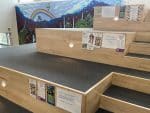
Co-principal Jean Berthiaume explains his understanding of a community-based school as “a school that challenges boundaries. Schools are commonly accepted to have walls and doors, but we want to see students being able to explore the world, to apply their learning to authentic and real-world situations.” While Winooski School District (WSD) has not officially worked with the Coalition for Community Schools or the Vermont Act 67 community schools grant program, they intentionally use a community-based approach in designing their learning environment.
As we described in our opening post for this series, six practices define community schools. These are:
- Powerful student and family engagement
- Collaborative leadership and shared power and voice
- Expanded and enriched learning opportunities
- Rigorous, community-connected classroom instruction
- Culture of belonging, safety, and care
- Integrated systems of support
This post explores the ways in which Winooski enacts these six key practices.
Student and Family Engagement
“Families and students actively participate in the school community and are key partners in decision-making, shaping the school’s environment, priorities, and partnerships. Families’ lived experiences and wisdom inform approaches to student success.” (Community Schools Coalition)
The origins of the Winooski transformation started with the community process that led to their graduate expectations, similar to what others might call a portrait of a graduate or learner. Over the years, active engagement and participation in the school has become part of the fabric of the community. This holds true for day-to-day engagement, the services offered at the school, and for larger projects, such as the recent building expansion and renovation. When larger projects appear on the horizon, the school board and school leadership invite community input and design with community-centered values in mind. The alignment in the culture and process reinforce interactions, decisions, and spaces that support engagement.
Information flows regularly through established channels, such as regular newsletters (including one created in partnership by the City of Winooski and WSD) and social media platforms. A family engagement committee works to increase outreach and engagement and hosts family workshops. Communications Director Miriam Greenfield shares that “currently, they are working on a video series for the main languages in the district. Main languages include English, Nepali, Somali, Swahili, Spanish, French, Burmese, Arabic, Portuguese and Vietnamese.”
Collaborative Leadership and Shared Power
“Families, students, teachers, principals, and community partners co-create a culture of professional learning, collective trust, and shared responsibility as they make decisions together.” (Community Schools Coalition)
The co-principal model at WMHS signals the value placed on collaborative leadership. Rather than having one principal at the middle school and one at the high school, the co-principals work together to lead the Instructional Leadership Team, encouraging “a common, scaffolded vision 6-12.” It affirms the commitment to building strong relationships with students and families over time and illustrates personalization in action, with co-principals Jean Berthiaume and Kate Grodin taking on different roles that reflect their areas of expertise and passion.
Teachers also take on leadership roles in a variety of ways and have agency to enact community-connected and personalized learning in ways that fit their style. Teacher representatives participate on the Instructional Leadership Team and lead on planning events such as the Community Iftar. Though time is always a precious resource, WMHS prioritizes professional learning, including at retreat days and an annual School Design Institute (SDI) over multiple days at the end of the school year. Originally launched with grant funding from the Barr Foundation, the district has continued to support the investment, which has provided time for teachers to learn the key elements of proficiency-based teaching and learning. Berthiaume explains that SDI “allows us to come together to reflect on units of study – an opportunity to make them better, to do the metacognition of teaching and learning, not just with a supervisor or principal, but with colleagues.”
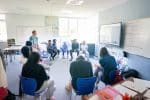
At times, students have been included in SDI or other forums to give feedback on their educational experiences and leaders named a goal of creating more such opportunities. Several students indicated that they feel they can raise concerns. In the Culture and Community Capstone class, two students were working on a proposal to offer additional world languages and there is a relatively new student voice committee within the school.
Between WSD and the broader community, there exists a shared commitment to the schools, students, and their families. Mohamed Diop, Director of Multilingual Learner Programs, explains, “The great thing about this place is that even the city – the mayor and her office – is very collaborative with the school. The police station, if you call them here, they come here. We share brains about projects. We work together to make things happen for the community members.” Diop and his team of six cultural liaisons from different backgrounds can offer input related to family needs and concerns from safety to food and housing security.
Students also use their voices to enhance the safety and sense of belonging for all members of the community. For example, the Winooski Antiracism Steering committee is in its fifth year with bi-monthly meetings, currently supported by UP for Learning, a non-profit organization based in Vermont with a mission to empower youth and adults to reimagine and transform education together. The committee was formed following a period of activism led by students, alumni, and others activism June to September 2020, which culminated in the Winooski School Board accepting and initiating action on five of the eight demands from the Winooski Students for Antiracism. Lindsay Halman of UP for Learning shared that current focus topics include cultivating more youth leadership, building ethnic studies curriculum, and diversifying the hiring process.
Across different levels of the school community, evidence of collaborative leadership and shared power shapes a culture of trust, learning, and community.
Expanded Learning Opportunities
“Before- and after-school, weekend, and summer programs provide expanded time, expanded staffing, and expanded opportunities for learning and engagement. Students have opportunities to explore their passions, dive deeper into the application of academic content, and strengthen their knowledge and skills.” (Community Schools Coalition)
WMHS provides numerous opportunities for students to meet graduation requirements and expectations outside of the classroom. Supported by Vermont’s Flexible Pathways Initiative a range of opportunities, mainly for high school age students, exists at the school, including, but not limited to dual enrollment, career and technical education at multiple Vermont centers, and work-based learning. A personalized learning planning process helps students identify pathways and set goals related to their learning and postsecondary readiness, building on their personal interests and expanding the ways they can apply their knowledge and skills.
Many adults in the building help connect students to opportunities. Jessica Handrik, the Flexible Pathways and Work-Based Learning Coordinator, plays an essential role as a point person for developing partnerships, identifying opportunities, and helping students build their pathways. Her role mirrors that of the Community Coordinator position that is a cornerstone of the Coalition for Community Schools framework. Handrik teaches a career exploration class for ninth graders that kicks off student exploration of career, college, and community connections. She helps connect students to opportunities through partners and the city both during the school year and in summer, from referee and lifeguard training to the opportunities in this example newsletter. As of early May, they had visited 45 organizations for out-of-school career learning with 60-65% of freshmen and sophomores and 80-85% of juniors and seniors participating in at least one of the Flexible Pathways.
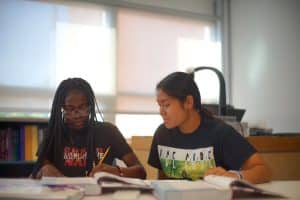
As opportunities become more in depth, such as with work-based learning, Handrik supports the creation of a training plan outlining roles and responsibilities, the industry-specific skills the student will be learning, and the target graduation proficiencies and graduation expectations. Recent example internships include working at the Humane Society, at local restaurants, and at a textile design company. Handrik adds that internships are often a vehicle for completing a graduation capstone and that there are also in-house internships: “We had a student achieve one of their capstones through doing an in-house internship with our facilities department; we’ve had students working in the library. Another student is currently working with the theatre department on technical lighting design.”
Alexis, a senior, shares the ways she’s applied her learning beyond the classroom. She explains, “for me specifically, I’ve been able to use what I’m doing in school to find myself job opportunities, internship opportunities, or even just sharing in general, like presenting my learning outside of the classroom. So for my culture and community capstone, I wrote a testimony about the importance of special education and was able to present that to the Board of Education at the State House.”
Winooski prioritizes providing equitable access to a range of opportunities and aspires for every student to find their passion. For example, a newly formed high school robotics team competed at the Vermont Regional FIRST® (For Inspiration and Recognition of Science and Technology) Technical Challenge, a program that mentors students who are interested in STEM careers. Handrik beamed as she shared: “The students were so amazing… they actually gave us the Judges Choice Award for plucky determination… It connects these students to Global Foundries, a local business, and a professor of electrical engineering at UVM is our second mentor.” At the elementary level, a lego engineering program has started, which creates the potential for a K-12 throughline.
Community-Connected Classroom Instruction
“Teaching and learning in the school infuses high-level content and skills with real-world learning opportunities. The curriculum is deeply connected to the local community and students’ identities, cultures, and experiences, providing opportunities for students to engage in meaningful inquiry-based learning and problem-solving.” (Community Schools Coalition)

Several curricular features of the WMHS system bridge academic content, transferable skills, and opportunities to apply learning in the community. In the middle grades, interdisciplinary expeditions happen two to three times a year and culminate in a showcase of learning. Expeditions “encourage students to tackle engaging questions and problems, collaborating with teachers, peers, and professionals” (WSD Presskit 18 March 2025). For example, the 6th-grade Academy, which supports the transition from elementary grades, features a Circus Expedition, which incorporates a 3-week residency with Circus Smirkus, a Vermont non-profit that engages students in learning about the circus arts, and focuses on teamwork and social-emotional learning.
At the high school grades, the iLab course offers students opportunities to explore interests outside of the mainstream curriculum by doing a student-directed project. Students can take iLab more than once, pursuing different topics to meet graduation requirements. Learners have the option to pursue their perseverance capstone through iLab, allowing them to meet graduation requirements while pursuing their passions, which often contribute to solving real community challenges.
In every iLab project, students must engage with someone in the community who has experience or expertise in whatever it is they are learning about. Lindsay Cox, an iLab teacher, offers an example: “a student who is doing a project on learning American Sign Language will find someone in our community who knows sign language and can come in and be a learning partner for that student.” She adds, many of the capstone projects – whether in iLab or other settings – “have to do with either supporting some sort of problem solving in the community or taking an inquiry question and really figuring out what it means for us here in Winooski before taking it more state level or national.”
Culture of Belonging and Care
“The school climate is welcoming and fosters trust among students, families, partners, and staff. Each person in the school community is valued for their rich diversity of experiences and is encouraged to share their views, knowledge, and culture.” (Community Schools Coalition)
The myriad practices and systems described in this series – for engaging students and families, building relationships, and learning by doing in ways connected to the broader community – all cultivate and are supported by a culture of belonging and care. Families experience this culture when they come to the school for events whether related to academics, extracurricular activities, or cultural celebrations. From students to teachers to administrators, the sense of community is consistently named as what makes Winooski special.
Winner, a senior, describes how “everybody’s very welcoming…when new people come in that don’t know how to speak English, they’re taken really good care of and students really try to interact with them. I don’t speak another language, [but for me] the diversity just makes a big difference.” Leo, another senior, sees the intentionality in creating a culture of belonging.
“I really do think that here, maybe one of the objectives of the school really is to make sure that everybody has a place, either in the school or somewhere, where they feel they belong, and they feel like they have that sense of community, which I think is a really important thing, not only for academics, but also on a personal level. Kids do better when they feel like they belong in academics, but they also, that helps them have better mental health, have better physical health, have better all these kinds of things. I think that that’s something that I really appreciate about Winooski, is that sense of community.”
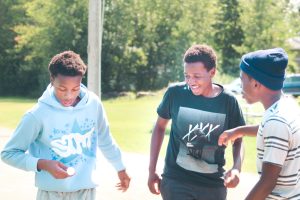
The culture also empowers and encourages students to develop and exercise their agency, which further sustains the community. The Unheard Stories group illustrates an example of student leadership in creating a culturally affirming place. Created by two immigrant students, students come together each week after school to speak about their experiences. Noblette, a senior who came to Winooski six years ago, shared, “Unheard Story really helped me, because I get to speak what is in my mind, and I met a lot of new people. Last year we did only people from Africa, but now we are doing people who wanna share their story…some people were born here, have different experiences as Americans, so we come together.” At the end of the year, they have a performance where students wear clothes from their home cultures and share stories.
Integrated Systems of Support
“A dedicated team composed primarily of school staff and community partners intentionally and systematically coordinates services, supports, and opportunities that foster individual and collective well-being, using an assets-based approach to nurture the strengths and address the needs of students and families.” (Community Schools Coalition)
Co-principal Kate Grodin describes how she thinks of a community-based school as a “watering hole for the community and for families in particular. For me, it’s a school that opens before instruction begins and closes well past the last class or the last bell has rung. It looks at students and families’ needs holistically. It provides support and education beyond your typical academics.” The wrap-around services offered in WSD bring this idea to life from the health and dental clinic to food security supports such as the necessities store, run in partnership with the Vermont Food Bank and programs like VeggieVanGo, which distributes fresh produce.
Diop explains, “We’re here for not only the students. We are here for the parents as well. That’s where, when I meet with the parents, we open our arms, ‘Please tell us honestly…There is nothing you need to hide. We’re here as a team.’ The school community is school administrators, staff, students, community members, working together to make things work.” Later he affirms that the roles, systems, and culture the school has built is making a difference for both students and the community. He reflects: “Some community members can witness, can tell stories just about the support they received from us to actually be able to live in Winooski. And I feel like if I was not a part of this or nobody helped with this situation, we may have lost students. They could have become homeless or moved out of Winooski.”
Wellbeing is one of the graduate expectations and mental health supports are not stigmatized. A commitment to community connection underlies the philosophy of support. Diop explains,
“In my role specifically, I believe education starts from home and there are three different schools in life. The first school is home, second one is the neighborhood where the student lives. The third school is this actual school right here. Having that in my mindset, I always prioritize the student’s wellbeing. And I believe a student’s readiness for academics cannot happen until the first school is settled, second school is settled, and then the third.”
Building from a foundation of trusting relationships increases student readiness for learning. Students feel supported as whole people, a product of the strong relationships built in advisory with their teachers and staff.
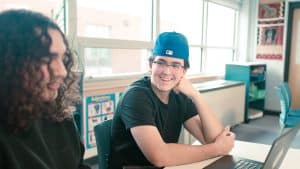
Conclusion: Community and Learning Connect
The work of a community school like WMHS spans from the building design to the learning system. Cox sums up the integration of the school and the community, explaining, “One of the things that being connected to the community means for Winooski High School is ensuring that what’s going on in the community is allowed to take space and be amplified in our building. And it also means that what’s happening in the building, the learning and everything else can be connected and integrated into what’s going on in the community space.” Many of the features of the Winooski community-driven system also translate to the elements of competency-based education, which we’ll explore in the next post of the series.
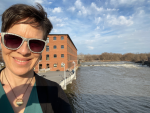 Laurie Gagnon is the CompetencyWorks Program Director at the Aurora Institute. She leads the work of sharing promising practices shaping the future of K-12 personalized, competency-based education (CBE). Laurie lives in Somerville, MA with her partner, young son, and cat.
Laurie Gagnon is the CompetencyWorks Program Director at the Aurora Institute. She leads the work of sharing promising practices shaping the future of K-12 personalized, competency-based education (CBE). Laurie lives in Somerville, MA with her partner, young son, and cat.